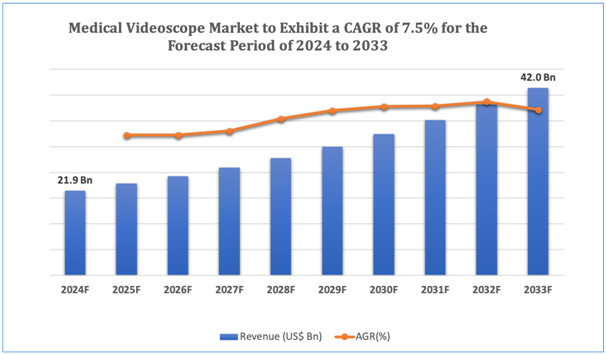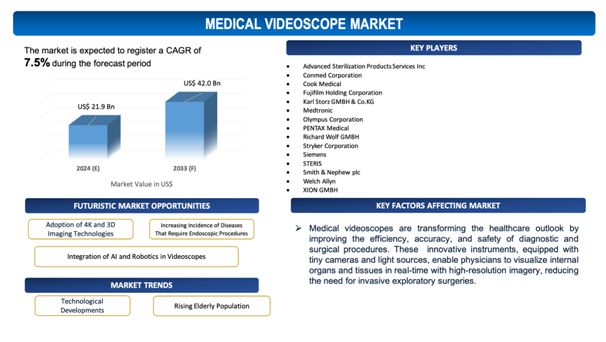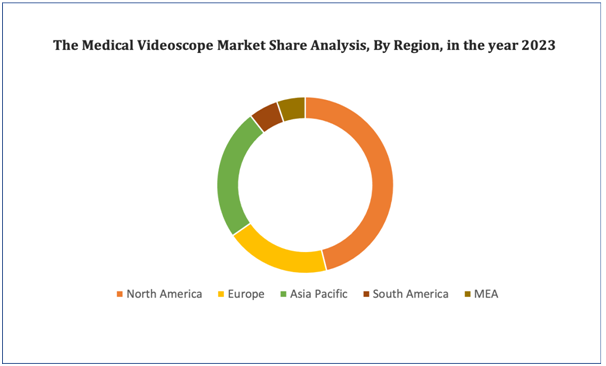Medical VideoscopeMarket Overview
The global medical videoscope market is estimated to be worth over USD 42Bn in 2033 and is expected to grow at CAGR of 7.5% during the forecast period (2024-2033).
Medical videoscopes are transforming the healthcare outlook by improving the efficiency,accuracy, and safety of diagnostic and surgical procedures. These innovative instruments, equipped with tiny cameras and light sources, enable physicians to visualize internal organs and tissues in real-time with high-resolution imagery, reducing the need for invasive exploratory surgeries. Medical videoscopes are broadly used in different medical specialties, comprising urology, gastroenterology, pulmonology, and minimally invasive surgeries, making them anessential tool in advanced healthcare.
One of the primary benefits of medical videoscopes is their capability to offer clear, detailed images of internal structures, allowing early and accurate diagnosis of conditions such as ulcers, tumours, and obstructions. In gastroenterology, for instance, endoscopic videoscopes are used to detect and monitor gastrointestinal diseases like colorectal cancer, one of the most common types of cancer globally. This technology has greatly improved patient outcomes by supporting early detection and treatment, reducing the need for more invasive procedures.
In surgical applications, medical videoscopes are revolutionizing the field of minimally invasive surgery (MIS). Procedures such as laparoscopic surgeries, which require only small incisions, are made possible through the use of videoscopes. This reduces patient recovery times, minimizes the risk of complications, and leads to better postoperative outcomes. With smaller incisions, patients experience less pain and scarring, which enhances their overall quality of life. In addition, the ability to capture real-time, high-definition footage aids in surgeon precision and contributes to more successful operations.
Innovations in videoscope technology, such as the incorporation of 3D imaging, robotics, and AI have further enhanced their capabilities. AI-powered videoscopes, for instance, can assist in diagnostics by highlighting abnormal tissues or structures, while robotic-assisted videoscopes offer higher precision and control during complex surgeries. These advancements are helping to push the boundaries of what is possible in both diagnostics and therapeutic interventions.
Overall, medical videoscopes are transforming healthcare by allowing less invasive, more accurate procedures, improving patient outcomes, and reducing healthcare costs. As technology continues to advance, videoscopes are expected to play an even more integral role in the future of diagnostic and surgical care.
Figure 1. Medical Videoscope: Market Size

Get more details on this report - Request Free Sample
Key Market Insights
The global medical videoscope market is witnessingrobust growth, fuelled by increasing demand for minimally invasive procedures, developments in imaging technologies, and the soaring prevalence of chronic diseases. Latest market insights indicate that videoscopes are increasingly being adopted in different medical fields such as gastroenterology, urology, pulmonology, and orthopaedic surgeries due to their ability to offer high-resolution, real-time visuals of internal organs, improving diagnostic accuracy and surgical precision.
Significant developments in the market comprise the incorporation of 3D imaging, robotic assistance, and artificial intelligence (AI) into medical videoscopes. These developmentsimprove surgeon control, accuracy, and visualization during procedures. For instance, robotic-assisted videoscopes offer increased dexterity and precision, particularly in complex surgeries, while AI-powered systems can assist in detecting abnormalities and improving diagnostic outcomes. Moreover, the use of 4K ultra-HD and 3D imaging technologies in videoscopes has enhanced image clarity and depth perception, further improving the efficacy of minimally invasive procedures.
The market outlook is also defined by growing investments in healthcare infrastructure, particularly in emerging markets, and the rising focus on early detection of diseases like cancer and gastrointestinal disorders. Significant players are continuously innovating to offer lighter, more flexible, and advanced videoscopes, which enhance patient comfort and operational efficiency. Alongside, the push for cost-effective and portable solutions in outpatient and ambulatory care settings is expanding the market reach. Thus, the global medical videoscope market is poised for continued growth as technology continues to advance and healthcare providers prioritize minimally invasive diagnostics and treatments.
Market Dynamics
Market Drivers
Rise in the Minimally Invasive Surgeries
The surge in minimally invasive surgeries (MIS) is a primary driver of growth in the global medical videoscope market. Minimally invasive procedures, which need smaller incisions in comparison to conventional open surgeries, have become progressivelyprominentowing to their several benefits, comprisinglessened pain, faster recovery times, shorter hospital stays, and lesser risk of complications. Medical videoscopes, equipped with high-resolution cameras and flexible designs, are critical tools in performing these procedures, as they enable surgeons to visualize internal organs and tissues in real-time without the need for large incisions.
The demand for minimally invasive surgeries has risenattributing to the soaring prevalence of conditions such as gastrointestinal disorders, cancer, and cardiovascular diseases, which often need diagnostic and therapeutic interventions. Videoscopes allow precise visualization and manipulation of surgical instruments, allowing for more accurate and efficient procedures. In specialties like gastroenterology, urology, and laparoscopy, the use of videoscopes has become indispensable in both diagnostics and treatment.
Moreover, technological advancements in videoscope design, such as the integration of 3D imaging, high-definition (HD) cameras, and robotic assistance, have further improved the capabilities of minimally invasive procedures. These innovations offer enhanced image clarity, depth perception, and surgeon control, leading to better patient outcomes and greater adoption of MIS across healthcare facilities.
As the trend towards minimally invasive surgeries continues to grow worldwide, the demand for advanced medical videoscopes is estimated to rise, fuelling the overall growth of the medical videoscope market.
Market Restraints
With regard to numerous advantages of medical videoscope, the market faces several challenges due to the unique characteristics and requirements associated with these potent pharmaceutical products. Some of the key market challenges include:
- High Cost of Advanced Videoscopes: The cost of acquiring and maintaining advanced medical videoscopes, particularly those incorporatedwith technologies like 3D imaging, AI, and robotic assistance, can be prohibitively high for smaller healthcare facilities and developing regions. This limits the adoption of these devices in lower-income areas, limiting market growth.
- Lack of Skilled Professionals: The usage of medical videoscopes, especially in complex procedures, needs highly trained professionals. A shortage of skilled operators, particularly in emerging markets, can hamper the effective use of videoscopes, impacting their overall adoption and utilization in the healthcare system.

Get more details on this report - Request Free Sample
Market Opportunity
IncreasingIncidence of Diseases That Require Endoscopic Procedures
The growing incidence of diseases that necessitates endoscopic procedures presents a significant market opportunity for the global medical videoscope market. Conditions such as gastrointestinal disorders, colorectal cancer, and respiratory diseases are on the surgeacross the globe, fuelled by elderly populations, poor dietary habits, and lifestyle factors such as smoking and alcohol consumption. These conditions often need endoscopic diagnostics and treatments, as videoscopes enable healthcare providers to visualize internal organs with precision, aiding in early detection, accurate diagnosis, and effective intervention.
For instance, the growing prevalence of gastrointestinal disorders like ulcers, Crohn’s disease, and colorectal cancer has spurred demand for endoscopic procedures, particularly colonoscopies and gastroscopies, where medical videoscopes are crucial for visualizing and diagnosing abnormalities. Similarly, in respiratory diseases such as lung cancer and chronic obstructive pulmonary disease (COPD), bronchoscopies supported by videoscopes hold a crucial role in detecting issues at an early stage.
Moreover, the surge in lifestyle-associated conditions like obesity has led to an increase in bariatric surgeries, many of which are performed using minimally invasive techniques with the help of videoscopes. This soaring need for endoscopy in both diagnostics and therapeutic applications is driving demand for advanced medical videoscopes, creating a significant opportunity for market growth.
As healthcare systems globallyfocus on early detection and preventive care, the demand for high-quality, advanced videoscopes is estimated to rise, offering substantial opportunities for manufacturers to innovate and expand their market presence.
Market Trends
- Adoption of 4K and 3D Imaging Technologies: The global medical videoscope market is witnessing a growing trend towards the adoption of 4K ultra-high-definition and 3D imaging technologies. These advancements provide clearer, more detailed visuals and enhanced depth perception, allowing surgeons to perform more accurate diagnostics and complex minimally invasive procedures with improved precision.
- Integration of AI and Robotics in Videoscopes: The integration of artificial intelligence (AI) and robotic assistance in medical videoscopes is another emerging trend. AI-powered videoscopes can aid in real-time detection of abnormalities, while robotic-assisted systems enhance surgeon control and dexterity during minimally invasive surgeries, contributing to better outcomes and increased adoption of advanced videoscopic procedures.
Medical Videoscope Market: Key Segments
By Product Type
- Videoscopes
- Visualization
- Documentation Systems
By Application
- Bronchoscopy
- Arthroscopy
- Laparoscopy
- Urology Endoscopy
- Neuroendoscopy
- Gastrointestinal Endoscopy
- Obstetrics/Gynecology Endoscopy
- ENT Endoscopy
- Others
By End User
- Hospitals
- Clinics
- Others
By Sensor
- CMOS Sensors
- CCD Sensors
By Key Geographical Regions
- North America
- Europe
- Asia-Pacific
- Middle East and Africa
- South America
Figure 4. Medical Videoscope Market: Distribution by Region

Get more details on this report - Request Free Sample
Medical Videoscope Market: Regional Analysis
North America dominates the medical videoscope market owing to the rise in the manufacturing costs and increasing of the elderly population. Furthermore, the rise in the prevalence of diseases that require endoscopy. Moreover, the growing inclination for minimally invasive surgeries will further boost the growth of the medical videoscope market in the region during the forecast period.
Asia-Pacific is projected to observe substantial amount of growth in the medical videoscope market due to the surge in the technological developments in medical cameras.
Leading Medical Videoscope Developers
Industry Trends and Global Forecasts, 2023-2035 report features an extensive study of the current market landscape, market size and future opportunities associated with the Medical Videoscopemarket, during the given forecast period. Further, the market report highlights the efforts of several stakeholders engaged in this rapidly emerging segment of the biopharmaceutical industry. Key takeaways of the Medical Videoscopemarket are briefly discussed below.
The report includes the list of players operating in the global Medical Videoscopemarket. Some of the key players include:
- Advanced Sterilization Products Services Inc
- Conmed Corporation
- Cook Medical
- Fujifilm Holding Corporation
- Karl Storz GMBH & Co.KG
- Medtronic
- Olympus Corporation
- PENTAX Medical
- Richard Wolf GMBH
- Stryker Corporation
- Siemens
- STERIS
- Smith & Nephew plc
- Welch Allyn
- XION GMBH
Medical Videoscope Market: Key Developments
- In October 2023, Olympus Corporation, a global medical technology company, announced the market launch of its next-generation EVIS X1™ endoscopy system, which will be on display and demonstrated Oct. 22-24 during the American College of Gastroenterology (ACG) annual meeting in Vancouver, Canada.
Scope of the Report
The market report presents an in-depth analysis of the various firms / organizations that are engaged in this market, across different segments, as defined in the below table:
|
|
Key Report Attributes |
Details |
||
|
|
Base Year |
2023 |
||
|
|
Forecast Period |
2024-2033 |
||
|
|
CAGR (2024-2033) |
7.5% |
||
|
|
Product Type |
|
||
|
|
Application |
|
||
|
|
End User |
|
||
|
|
Sensor |
|
||
|
|
Key Geographical Regions |
|
||
|
Key Companies Profiled |
|
|
||
